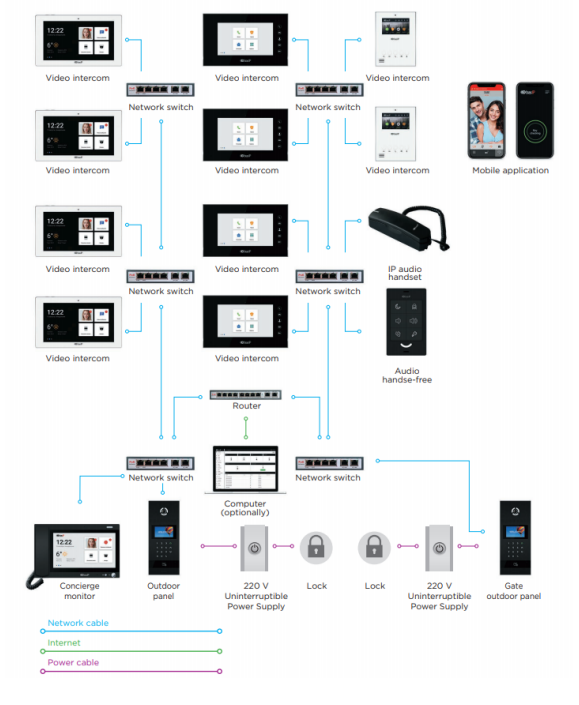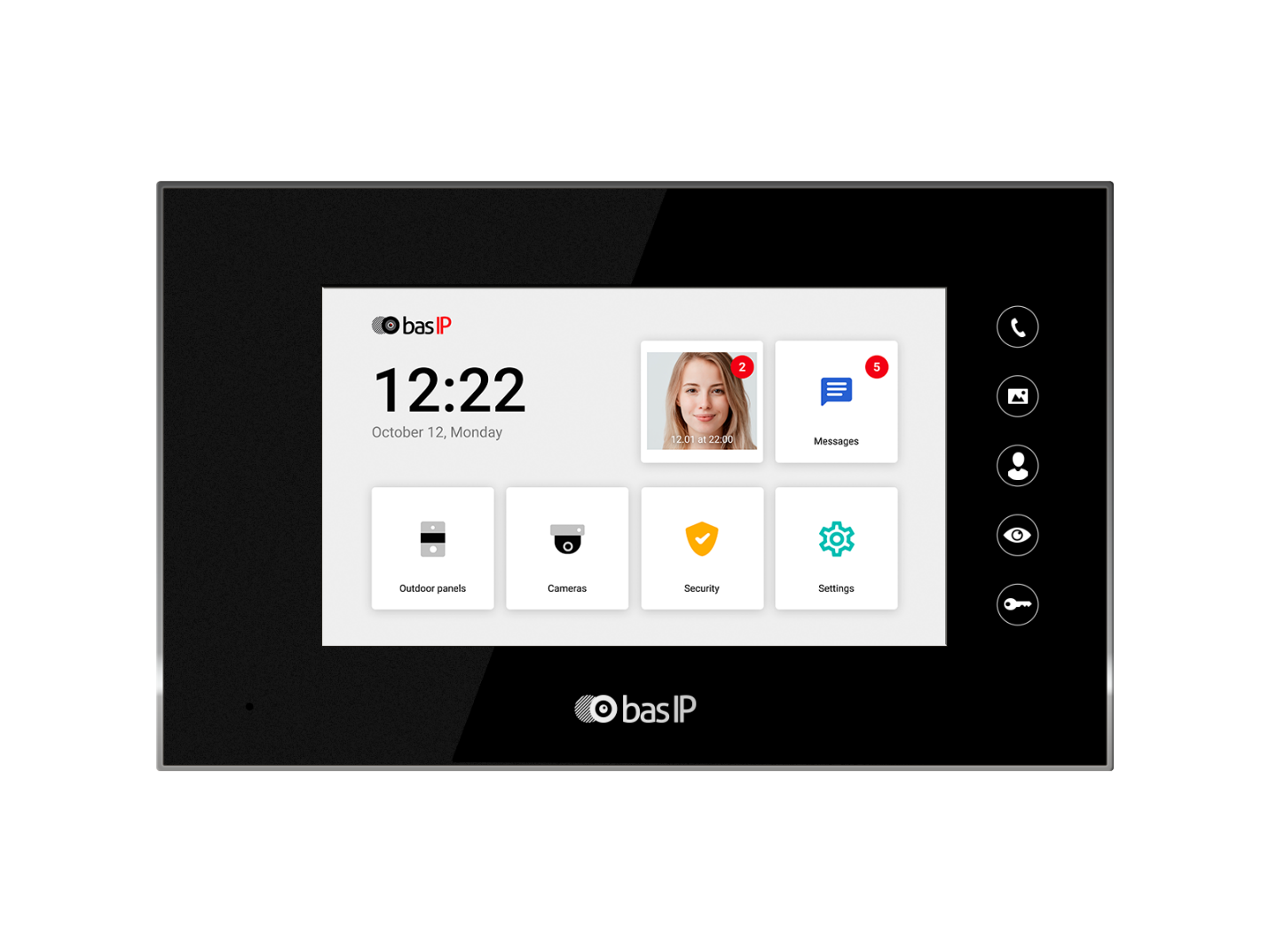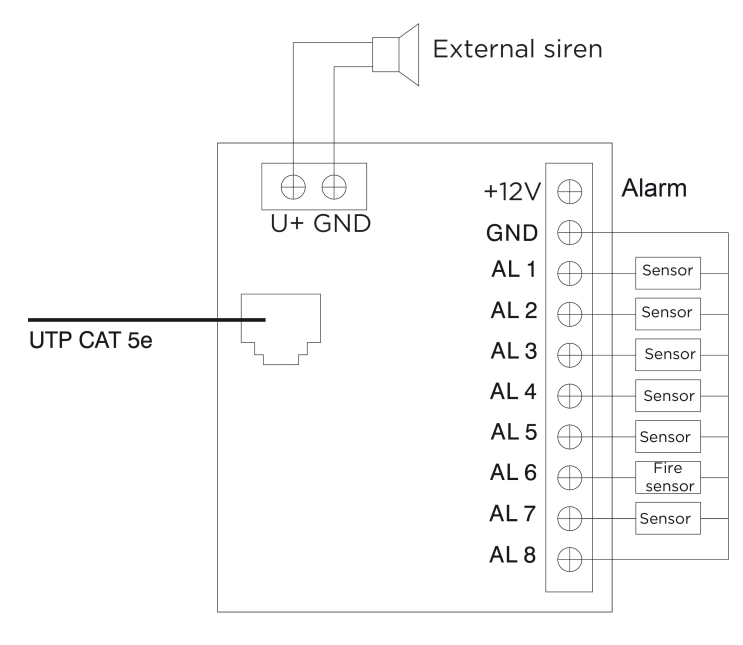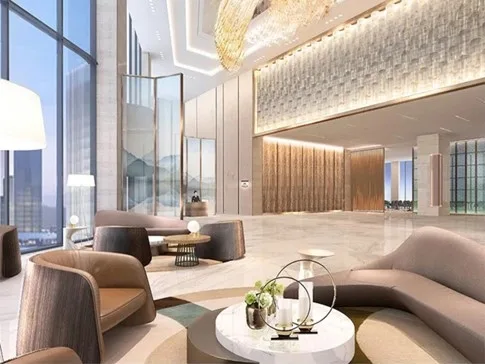BAS-IP is the first intercom system to use CAT5 cabling for its installation, both for the external network between the various buildings and for the trunks used to connect the apartments.
The IP network used for BAS-IP must be private and also isolated from other IP networks in the building in order not to impair the function and correct operation of the system.

The BAS-IP structure is designed to meet the needs of any residential building, even with a large number of users: there are no limits to the expansion of the system and the number of trunks that can be managed.
It is not enough to simply describe BAS-IP as the latest generation of digital video intercom systems.
The versatility of the system and its modular capabilities can be used not only for access control management but also for video surveillance, security, and fire alarm systems – in addition to many other functions that are fully integrated.
BAS-IP is a system based on an “open” communications standard. The use of SIP (Session Initiation Protocol) allows the connection of third-party devices that use the same standard. However, to ensure the proper functioning of the system, it is advisable to use only BAS-IP certified devices.
Digital Audio/Video Transmission
In a BAS-IP system, audio and video signals are transmitted digitally over an IP network. This means that sounds and images are converted into numbers, or digits, before being transmitted from one device to another.
In order to make the video smooth enough, the system must capture multiple images at once, called frames per second.
Typically, at least 25 frames per second are needed so that the human eye can observe images and perceive motion, continuously and smoothly between the current frame and the subsequent frame.
It is also necessary that the resolution of the stored images be good enough to obtain an acceptable clarity of detail. All these features require a large amount of (digital) data to be sent over the IP network, which can overload its capacity while sending large amounts of data at the same time.
To solve this problem, appropriate mathematical algorithms are used to “compress” the information before sending it through the network. Once accepted, this information can be “unpacked” using the reverse process and ready for use.
These algorithms are called “CODECs” (coding and decoding). They are essentially software or hardware devices that encode and/or decode an audio or video signal in digital form in order to store it in a storage device, from where it can later be retrieved for reading or, as in the BAS-IP case, transmitted to an IP communication channel.
In the encoding/decoding phase, the codecs also compress (and/or decompress) the data, reducing the data volume in order to facilitate the transmission of encoded data.
Data compression allows us to use lower bandwidth channels to transmit data, leaving more room to transmit similar or other information needed for system operation.
Technological advances have made it possible to create more efficient codecs capable of providing a high level of quality (high image resolution, frames per second) while maintaining the small amount of data needed to send information to the network.
Bas-Ip Uses Two Different Standard Codecs – One for Video Data and One for Audio Data:
H.264: This codec was originally developed by Apple Computers. It is quite efficient and is used for the latest generation of cell phones (3G) as well as for streaming high-definition (HD) movies on the Internet.
In fact, this codec is capable of providing video quality on par with the MPEG-2 encoding standard used in DVD, reducing the speed by a third or even half of the requested speed (bit rate) for transmitting the information.
With the H.264 codec, BAS-IP can manage a large number of dialogs simultaneously, maintaining high quality and smooth images (640 x 480 pixels at 30 fps).
G.711: Codec designed for use in VoIP technology. It is one of the main codecs used in this area. G.711 allows you to get excellent sound quality with a sufficiently low bit rate (64 Kbps) and minimal processing time of the required compression/decompression algorithm.
General System Characteristics
BAS-IP includes many features that enable solutions for residential complexes of considerable size. The potential and strengths of BAS-IP are presented in the following list, which includes the main features of BAS-IP in various areas of expertise.
Cabling and Installation
- BAS-IP uses UTP2 CAT5 cable for the IP network and trunks, making installation and wiring simpler.
- BAS-IP’s extremely flexible architecture allows for a system that runs completely on IP networks (with a core network and trunks), a combined system (IP networks for the core network and CAT5 networks for trunks), or a hybrid system (IP for the core network; IP and CAT5 for trunks).
- All BAS-IP devices present in the IP network, except the concierge desk and VoIP telephones, are directly powered via a data cable by PoE (Power over Ethernet) technology. This feature also contributes to a simpler and more economical installation.
- The ability to use fiber optic cables to cover long distances means that BAS-IP has no limitations when there are long distances between IP network devices.
Sound and Video Quality
- As mentioned above, BAS-IP uses the H.264 standard as the video codec. This provides high-quality digital video at 30 fps and gives the images excellent smoothness.
- Similarly, audio streams are transmitted at maximum speed, according to the G.711 standard.
Expandability
The use of digital technology allows BAS-IP is not limited in terms of:
- Expansion and length of the IP network (since fiber optic cables are used).
- The number of trunks.
- A number of concierge consoles.
- A number of connected users.
- A number of simultaneous calls: a basic requirement in large housing estates.
If the IP network is used also for trunking, the number of system users is not limited because the addressing range of the system is virtually unlimited. Note that when the number of users grows, the amount of traffic managed by the IP network will increase.
Therefore, the IP network must be carefully designed to provide the characteristics necessary for proper operation.
Connecting Apartment Intercoms
To connect BAS-IP apartment intercoms, strictly follow the diagram:











